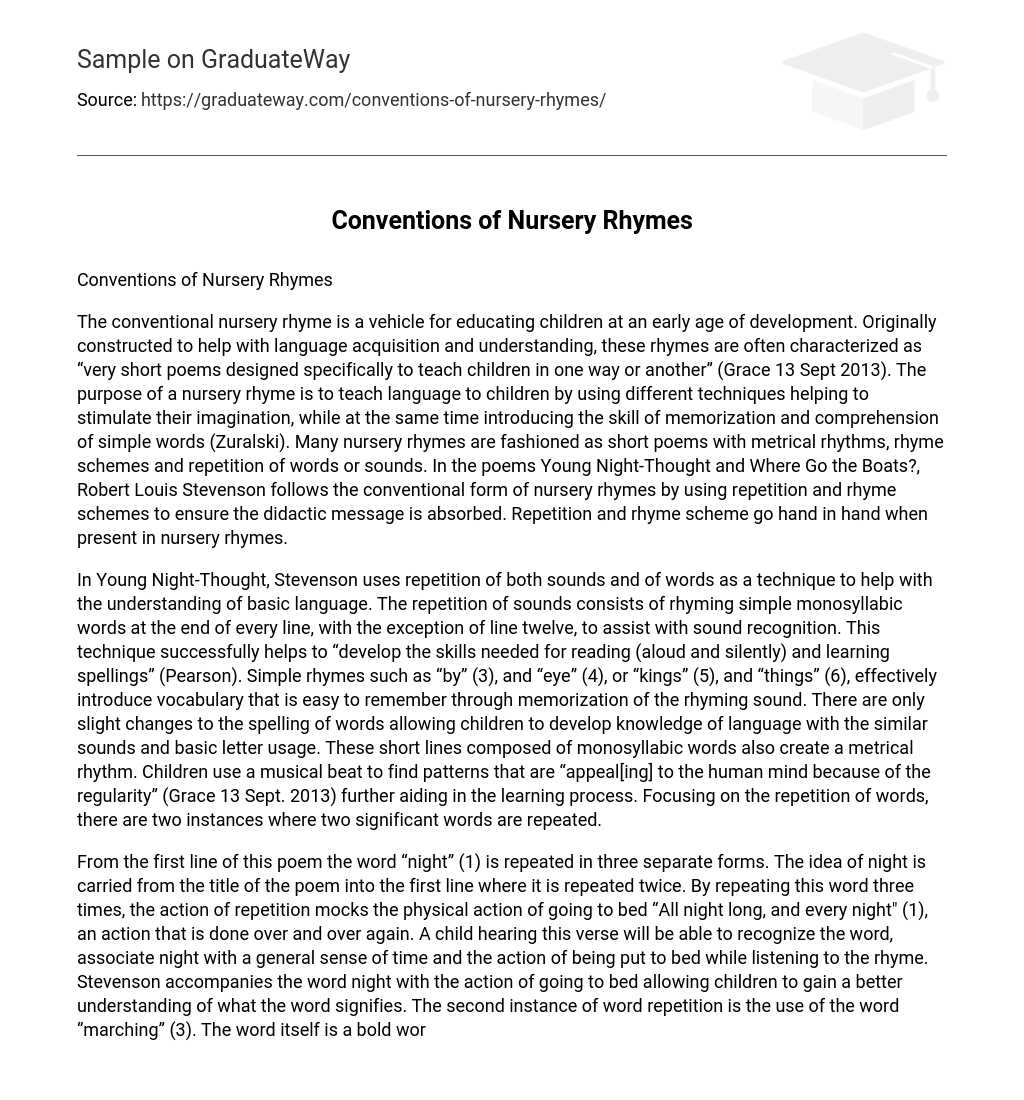The traditional nursery rhyme serves as a means of educating young children, aiding in their language development and understanding. These rhymes, considered “very short poems designed specifically to teach children in one way or another” (Grace 13 Sept 2013), aim to stimulate imagination, promote memorization skills, and enhance comprehension of simple words (Zuralski). Many nursery rhymes adopt the structure of short poems, featuring metrical rhythms, rhyme schemes, and the repetition of words or sounds. Robert Louis Stevenson employs repetition and rhyme schemes in his poems “Young Night-Thought” and “Where Go the Boats?” to adhere to the conventional form of nursery rhymes and effectively convey didactic messages. The presence of repetition and rhyme scheme forms an interconnected approach within nursery rhymes.
In his poem “Young Night-Thought,” Stevenson employs repetition of both sounds and words to aid in the comprehension of basic language. The repetition of sounds involves rhyming simple one-syllable words at the end of each line, except for line twelve, to facilitate sound recognition. This technique effectively contributes to the development of reading skills, both aloud and silently, as well as spelling acquisition (Pearson). Through the use of simple rhymes like “by” (3) and “eye” (4), or “kings” (5) and “things” (6), easily memorable vocabulary is introduced through the repetition of rhyming sounds. The spelled words undergo minimal changes, enabling children to grasp language patterns and basic letter usage. Additionally, these concise lines composed of monosyllabic words establish a metrical rhythm, where children can discern musical beats and identify “patterns that are pleasing to the human mind due to their regularity” (Grace 13 Sept. 2013), further facilitating the learning process. Regarding word repetition, there are two instances where two significant words are reiterated.
In this poem, the word “night” is repeated in three different forms, from the title to the first line. By repeating it three times, the poem imitates the repetitive action of going to bed. Children can understand and associate the word with bedtime while listening to the rhyme. Stevenson pairs the word “night” with the action of going to bed, helping children understand its meaning. Another repeated word in the poem is “marching.” It is a strong word that can be visually understood by children through actions. Stevenson uses this powerful action-word to describe fantastical figures like armies, emperors, and kings, appealing to a child’s imagination and expanding their language skills. Like the first poem we studied, Stevenson’s “Where Go the Boats?” is a short and simple nursery rhyme made for children.This verse employs a slightly intricate pattern of rhymes. It alternates between disyllabic words that may or may not rhyme, and monosyllabic words that do.
One important point to note is that even though the words in the poem may not rhyme, they still have the appropriate syllables to match the beat or produce similar sounds without having the same spelling. This maintains the metrical structure typically found in nursery rhymes, while conveying a more intricate didactic message. For instance, the words “sand” (2) and “hand” (4) have almost identical sounds except for one letter, making them simple and easy to remember rhymes. On the other hand, disyllabic words like “river” (1) and “ever” (3) present a slight challenge for children to pronounce due to their completely different spellings. However, these words can still be easily understood by children because they have matching syllables. Shifting slightly to focus on word repetition in the poem, it bears resemblance to Young Night-Thought as both poems feature the repetition of two distinct words three times. The first word repeated by Stephenson throughout the poem is “the river” (1), appearing in the first, ninth, and thirteenth lines. The placement of “river” in the first line is interesting as it provides an answer to the question posed in the title “Where Go the Boats?” This repetition of the word helps young listeners associate it with the idea that boats can be found at rivers, while also identifying the central question being asked in the poem.Through constant repetition, a child will develop an understanding of the connection between the boats and the river. Stephenson also emphasizes the word “Away” repeatedly in this poem. Interestingly, unlike other forms of repetition in the text, it is introduced in a distinct way. Specifically, the word is consecutively repeated at the start of three different lines: “Away down the valley, Away down the hill.”
The literary technique of anaphora, seen in the phrase “Away down the river” (11,12,13), creates a pattern at the start of each line. This repetition gives the feeling of constant movement, similar to a boat going down the river. Even though children may not fully understand this term, they recognize the repeated use of “away” and imagine the boat passing by familiar objects. Robert Louis Stevenson’s poetry follows the traditional structure of nursery rhymes, embedding a didactic message through repetition and rhyme. While nursery rhymes may seem simple, they have a complex structure aimed at educating children. In poems like Young Night-Thought and Where Go the Boats?, Stevenson shows how specific elements of nursery rhymes are crucial for successful narratives.
Works Cited
Grace, Dominick M. ENG 2033E Children’s Literature Course Notes. London, Ontario: Brescia University College, 13 Sept. 2013. Lecture Notes. Pearson, Longman. “Teaching Nursery Rhymes .”PEARSON. Copyright Pearson Education. Web. 6 Oct 2013. . Stevenson, Robert Louis. A Child’s Garden of Verses. New York: CHARLES SCRIBNER’S SONS, 1905. 6,16. eBook. . Zuralski, Andrea. The Fascination of Nursery Rhymes . GRIN Verlag , 2008. 5. eBook.





